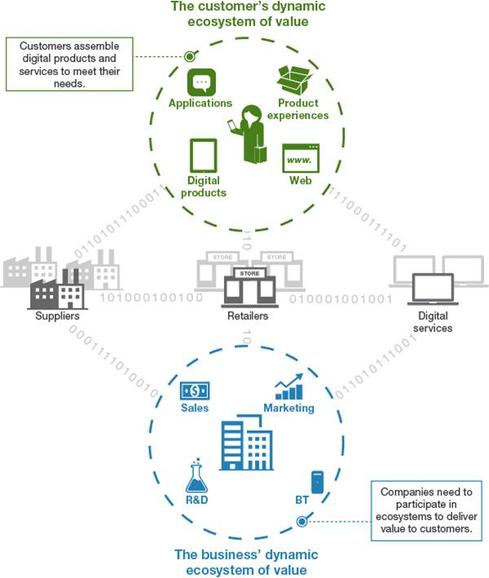Attaching new mobile apps or websites to an existing business does not make you digital. Immerse your products into the customer's ecosystem.

As a business leader, do you get the feeling you're no longer playing the same game you once played? It's not you; the world has changed. The things that used to set companies apart -- economies of scale, distribution strength, and brand -- are far less potent now. Why? Because digital technology has fundamentally changed two things: the dynamics of the markets in which you operate and the speed needed to stay competitive.
This shift has not gone unnoticed by business leaders. Seventy-four percent of executives in Forrester surveys report their company has a digital strategy. Typically, such strategies involve small departmental initiatives in marketing, e-business, or technology management, bolting digital apps, websites, or marketing on to the business.
[Is your company really a digital business, or does it just look like one? Here's how to tell the difference.]
However, in time, treating every new digital initiative as another bolt-on project creates organizational and technical chaos. This chaos intensifies the technology management challenge of having your organization's structures, technology, and metrics separated into functional building blocks, each fighting for scarce resources. As many companies eventually find out, a siloed approach to a digital strategy leaves your business vulnerable to nimble digital disruptors.
This is not IT's fault. The situation has evolved because we've built our businesses on a 100-year-old business model of supply chain efficiency. Indeed, IT has done a wonderful job helping businesses grow and automating business processes to deliver high-quality products and services. But our old models are being rewritten in the age of the customer. Instead of a supply-chain push from supplier to consumer, we now see consumers using products and services from a network of suppliers. Customers use digital technology to search rapidly for the services they need when they need them. If one supplier cannot meet their needs, another is just a tap or click away. Forrester calls this a "dynamic ecosystem of value."
To compete in the digital economy, your company must learn to create value inside each customer's unique ecosystem. For example, Walgreens opened up its photo printing capabilities via a digital interface, allowing developers of smartphone camera apps to let their users print directly at Walgreens. These photo apps were already a part of the consumer's ecosystem of value around photography; by opening its APIs to developers, Walgreens became a part of this ecosystem, opening the brand to a new set of customers. Walgreens now generates 15% of its photo-printing business from mobile devices.
Right now, your customers are looking for solutions to their problems using digital products and services from your suppliers, partners, digital disruptors, other customers, and competitors. They can do this because every company, every digital aggregator, every supplier, and every retailer is building apps and sites, making it effortless for customers to pick from a menu of everything they need, creating multiple "ecosystems of value."
As such, businesses can no longer be standalone entities. They must be part of a complex network of suppliers that customers assemble according to their needs. In Germany, Commerz Finanz's APIs opened up its consumer credit agreement process, allowing electronics retailers like Media-Saturn Group to offer loans right at the point of sale.
It's important to note that digital isn't just about gathering new external connections; it's about having the operational agility to act on them. Once you're wired into ecosystems of value, you can quickly pivot to add new business capabilities. For example, the retailer Tesco has built a network of drop-shipping suppliers using the delivery management vendor MetaPack. As a result, Tesco added more than 50 new suppliers to its network and is shipping a quarter million new items directly to consumers under the Tesco brand -- without increasing costs significantly.
All of this demands a business reset. You need to look at digital holistically, from the outside in, and apply digital thinking across everything your company does. Tomorrow's winners will be those who control the ecosystem and can tap its power.
Too many companies treat digital and mobile strategies as pet projects. Here are four ideas to shake up your company. Also in the Digital Disruption issue of InformationWeek: Six enduring truths about selecting enterprise software (free registration required).
About the Author(s)
You May Also Like







